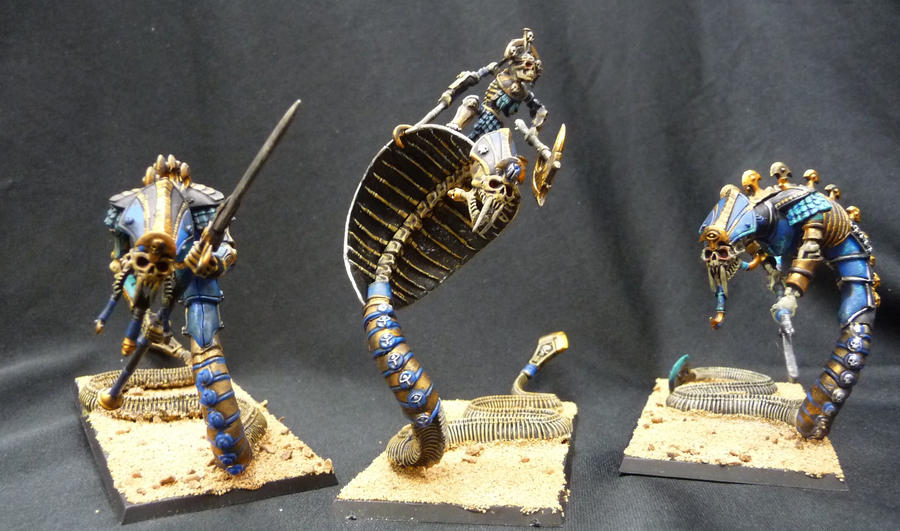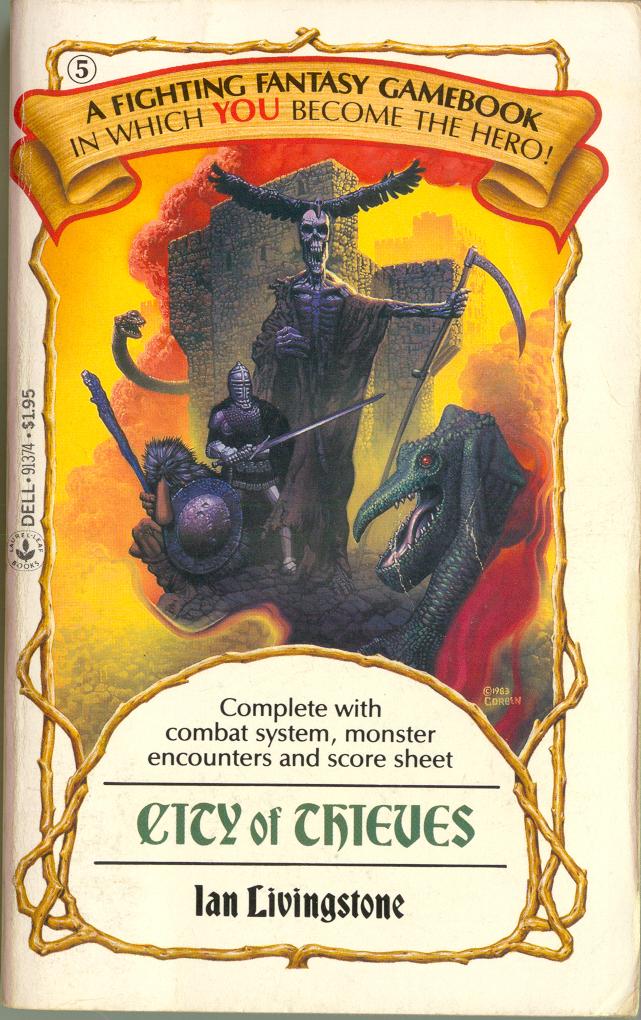PART FOUR: CITY OF SERPENTS Really about half the city, but this is the payola for the whole module; finally infiltrating the serpent
men held portion of the city, fighting a bunch of them, and rescuing Eando Kline so he can tell you how terrible their plan
really is and you can gear up for even more gratuitous snake killing in the last installment. The "random" encounters you're likely to have here are mostly patrols of six serpent
men fighters. (If you haven't noticed, yes—I emphasize the -men in serpentmen and lizardmen and ratmen too for that matter, because I refuse to bow to the politically correct nonsense that quietly changed them to serpentfolk and lizardfolk and ratfolk in the official crazy Seattle sources. Now that I've pointed that out, I can probably just quit using the italics, though.) There are also several non-random serpentmen guardposts with six or more soldiers standing there keeping watch. All in all, you could conceivably kill a couple dozen serpentmen guards just wandering around town. According to the module, they are disciplined enough to maintain their post even if they hear a disturbance from somewhere else in the city, which is mostly good for the PCs, if perhaps unlikely in real life. Then again, who knows what snake men would do if they existed in real life?
For some reason there are also four vrocks (vulture demons) literally dancing in one of the street intersections, and they attack anyone who comes by. Why the snakes haven't attended to that obvious threat is... I dunno. There's actually, other than that, surprisingly little to do or see in the snake section of the city, other than their big fortress. This is, of course, crawling with snakemen guards and advanced snakemen officers, but there's also a number of other monsters to fight in here. Let's go through what you'll face in the Thousand Fangs fortress:
There are stats for bloodwine, a potent drink that the snakes like, but which is poisonous to most other peoples. There are two "great cyclopses" that are dominated by the head snakey-head himself. There are also two iron golems (with snake heads) that you'll have to fight. How you can do this "stealthily" is beyond me, so most likely you won't actually.
There's a succubus spy, who works for the head-snake. Supposedly the vrocks came with her, but why they're out dancing in the streets is... I dunno. She'll pose as one of the dead companions of Kline, most likely, and follow the PCs around as a sympathetic help, looking for the best opportunity to stab them in the back (probably when something else dangerous is around.) She may even get away and plague the PCs later, although she has no other role in
this adventure.
The other major guest is the urdefhan defector mentioned in the last post. There are also four starving, savage gugs, trained to not attack serpentfolk hiding behind a secret door nearby. This means that Paizo treat gugs as if they're little more than animals, but in
The DreamQuest of Unknown Kadath, they are city-building and presumably civilized, if violent. After this, and a fair bit of wandering around exploring other rooms, many of which are not particularly interesting, you eventually stumble across the commander of the snake guard, sitting in his office oblivious to the carnage happening among his charges. In a moment that kind of made me chuckle, you can then go kill his harem of snake girls in his seraglio. Unless you decide that that's too sexist or something idiotic like that.
There's also a named snakey witch to kill, with a bunch of crap in her laboratory of magical research. There's also some strange thing called a "gohl" or serpent cloud, which is described as, "a conglomeration of thrashing, serpentine tails and three fanged snake heads with gold and emerald scales." There's a room full of the sarcophagi of magically hibernating snakemen from ancient times, guarded by a snakeman ghost sorcerer who's own hibernation was botched or something. It also tells you how you could wake them up, although how the PCs would figure that out or why they would want to is... I dunno. But the snakes now living here haven't really figured this place out either, and have been scared off by the ghost, so they haven't explored a secret chamber behind it, guarded by a chain lightning trap and having a bunch of magic items stashed away in it.
More secret and hidden doors lead to the dungeons below the temple. There's more guards here, unsurprisingly, and loads of imprisoned morlocks (like 200 of them.) They can be convinced, albeit with some difficulty, to riot and try and join their brethren, which creates a nice distraction for you, except by this point, you've already killed almost everything in the temple anyway. There are four snake-demon things here (fiendish spirit nagas, to be exact) as well as the actual body of the woman the succubus is impersonating. If she's still with the PCs, that'll be awkward for her, and she'll probably flee. You'll also probably kill the head snake torturer, at which point they'll finally find the famous Eando Kline.
Technically, the adventure is over at this point, but there's a few loose ends to wrap up. Do they go back to Izon and tell him that they killed his defector for him? Do they go back to the old morlock lady and tell him that they rescued her Pathfinder for her? Both? Neither? Do they interrogate Kline here and now (details of what he knows not included in this volume) because; I mean, after all the torture equipment is handy. (Heh.) Or do they take him back to the surface to rest and recover and tell them about the impending end of the world at his leisure? Or do they just tell him and his elf-lover Juliver to get to the surface on their own while they continue to explore the city and kill anything that's left in it?

If they do the latter, there's a small section on the city, including some encounters, that aren't directly related to the module, so are left to the appendix. Here, we have "serpentstone golems", which are animated statues of snakes and hydras with breath weapons—not a bad idea, and not unlike some of the old Tomb Kings troop types, as I recall. There's other treasures, traps, and some giant morlocks to deal with too.
The bestiary includes, along with "random encounters" which are mostly patrols and guards of things like morlocks, intellect devourers, urdefhans and serpentment. There's a few other things, but honestly, most of them fit poorly and I don't know why a GM would want to use any of them.
There's an "arcanotheign"—a strange herald of "mad god" of wizardry. There's some kind of giant cobra that supposedly comes from Zulu mythology (it's a little ridiculous at this point to pretend that African mythology has anything to do with an underground city of snakemen, though.) There's a folkloric Ugandan giant eel monster (same) and Zulu haunted tree. None of which I can imagine having anything to do with an underground serpentmen city.
And that wraps up the penultimate
Serpent's Skull adventure.
ISLES OF TERROR is moving along quit rapidly, isn't it? Much easier than my
CULT OF UNDEATH project was.






































